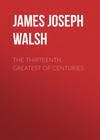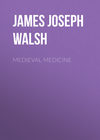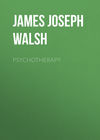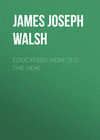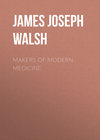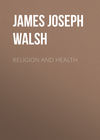Czytaj książkę: «The Thirteenth, Greatest of Centuries», strona 4
Succeeding Popes of the century were not less prominent in their patronage of education. Pope Alexander IV. supported the cause of the Mendicant Friars against the University of Paris, but this was evidently with the best of intentions. The mendicants came to claim the privilege of having houses in association with the university in which they might have lectures for the members of their orders, and asked for due allowance in the matter of degrees for courses thus taken. The faculty of the University did not want to grant this privilege, though it was acknowledged that some of the best professors in the University were members of the Mendicant orders, and we need only mention such names as Albertus Magnus and St. Thomas Aquinas from the Dominicans, and St. Bonaventure, Roger Bacon and Duns Scotus from the Franciscans, to show the truth of this assertion. To give such a privilege seemed a derogation of the faculty rights and the University refused. Then the Holy See interfered to insist that the University must give degrees for work done, rather than merely for regulation attendance. The best possible proof that Pope Alexander cannot be considered as wishing to injure or even diminish the prestige of the University in any way, is to be found in the fact that he afterwards sent two of his nephews to Paris to attend at the University.
All these Popes, so far mentioned, were not Frenchmen and therefore could have no national feeling in the matter of the University of Paris or of the French universities in general. It is not surprising to find that Pope Urban IV., who was a Frenchman and an alumnus of the University of Paris, elevated many French scholars, and especially his fellow alumni of Paris, to Church dignitaries of various kinds. After Urban IV., Nicholas IV. who succeeded him, though once more an Italian, founded chairs in the University of Montpelier, and also a professorship in a school that it was hoped would develop into a university at Gray in Franche Comte. In a word, looked at from every point of view, it must be admitted that the Church and ecclesiastical authorities were quite as much interested in education as in charity during this century, and it is to them that must be traced the foundation of the preparatory schools, as well as the universities, and the origin and development of the great educational movement that stamps this century as the greatest in human history.

JACQUES COEUR'S HOUSE (BOURGES)

CLOISTER OF ST. JOHN LATERAN (ROME)
III
WHAT AND HOW THEY STUDIED AT THE UNIVERSITIES
It is usually the custom for text books of education to dismiss the teaching at the universities of the Middle Ages with some such expression as: "The teachers were mainly engaged in metaphysical speculations and the students were occupied with exercises in logic and in dialectics, learning in long drawn out disputations how to use the intellectual instruments they possessed but never actually applying them. All knowledge was supposed to be amenable to increase through dialectical discussion and all truth was supposed, to be obtainable as the conclusion of a regular syllogism." Great fun especially is made of the long-winded disputations, the time-taking public exercises in dialectics, the fine hair-drawn distinctions presumably with but the scantiest basis of truth behind them and in general the placing of words for realities in the investigation of truth and the conveyance of information. The sublime ignorance of educators who talk thus about the century that saw the rise of the universities in connection with the erection of the great Cathedrals, is only equaled by their assumption of knowledge.
It is very easy to make fun of a past generation and often rather difficult to enter into and appreciate its spirit. Ridicule comes natural to human nature, alas! but sympathy requires serious mental application for understanding's sake. Fortunately there has come in recent years a very different feeling in the minds of many mature and faithful students of this period, as regards the Middle Ages and its education. Dialectics may seem to be a waste of time to those who consider the training of the human mind as of little value in comparison with the stocking of it with information. Dialectical training will probably not often enable men to earn more money than might have otherwise been the case. This will be eminently true if the dialectician is to devote himself to commercial enterprises in his future life. If he is to take up one of the professions, however, there may be some doubt as to whether even his practical effectiveness will not be increased by a good course of logic. There is, however, another point of view from which this matter of the study of dialectics may be viewed, and which has been taken very well by Prof. Saintsbury of the University of Edinburgh in a recent volume on the Thirteenth Century.
He insists in a passage which we quote at length in the chapter on the Prose of the Century, that if this training in logic had not been obtained at this time in European development, the results might have been serious for our modern languages and modern education. He says: "If at the outset of the career of the modern languages, men had thought with the looseness of modern thought, had indulged in the haphazard slovenliness of modern logic, had popularized theology and vulgarized rhetoric, as we have seen both popularized and vulgarized since, we should indeed have been in evil case." He maintains that "the far-reaching educative influence in mere language, in mere system of arrangement and expression, must be considered as one of the great benefits of Scholasticism." This is, after all, only a similar opinion to that evidently entertained by Mr. John Stuart Mill, who, as Prof. Saintsbury says, was not often a scholastically-minded philosopher, for he quotes in the preface of his logic two very striking opinions from very different sources, the Scotch philosopher, Hamilton, and the French philosophical writer, Condorcet. Hamilton said, "It is to the schoolmen that the vulgar languages are indebted for what precision and analytical subtlety they possess." Condorcet went even further than this, and used expressions that doubless will be a great source of surprise to those who do not realize how much of admiration is always engendered in those who really study the schoolmen seriously and do not take opinions of them from the chance reading of a few scattered passages, or depend for the data of their judgment on some second-hand authority, who thought it clever to abuse these old-time thinkers. Condorcet thought them far in advance of the old Greek philosophers for, he said, "Logic, ethics, and metaphysics itself, owe to scholasticism a precision unknown to the ancients themselves."
With regard to the methods and contents of the teaching in the undergraduate department of the university, that is, in what we would now call the arts department, there is naturally no little interest at the present time. Besides the standards set up and the tests required can scarcely fail to attract attention. Professor Turner, in his History of Philosophy, has summed up much of what we know in this matter in a paragraph so full of information that we quote it in order to give our readers the best possible idea in a compendious form of these details of the old-time education.
"By statutes issued at various times during the Thirteenth Century it was provided that the professor should read, that is expound, the text of certain standard authors in philosophy and theology. In a document published by Denifle, (the distinguished authority on medieval universities) and by him referred to the year 1232, we find the following works among those prescribed for the Faculty of Arts: Logica Vetus (the old Boethian text of a portion of the Organon, probably accompanied by Porphyry's Isagoge); Logica Nova (the new translation of the Organon); Gilbert's Liber Sex Principorium; and Donatus's Barbarismus. A few years later (1255), the following works are prescribed: Aristotle's Physics, Metaphysics, De Anima, De Animalibus, De Caelo et Mundo, Meteorica, the minor psychological treatises and some Arabian or Jewish works, such as the Liber de Causis and De Differentia Spirititus et Animae."
"The first degree for which the student of arts presented himself was that of bachelor. The candidate for this degree, after a preliminary test called responsiones (this regulation went into effect not later than 1275), presented himself for the determination which was a public defense of a certain number of theses against opponents chosen from the audience. At the end of the disputation, the defender summed up, or determined, his conclusions. After determining, the bachelor resumed his studies for the licentiate, assuming also the task of cursorily explaining to junior students some portion of the Organon. The test for the degree of licentiate consisted in a collatio, or exposition of several texts, after the manner of the masters. The student was now a licensed teacher; he did not, however, become magister, or master of arts, until he had delivered what was called the inceptio, or inaugural lecture, and was actually installed (birrettatio). If he continued to teach he was called magisier actu regens; if he departed from the university or took up other work, he was called magister non regens. It may be said that, as a general rule, the course of reading was: (1) for the bachelor's degree, grammar, logic, and psychology; (2) for the licentiate, natural philosophy; (3) for the master's degree, ethics, and the completion of the course of natural philosophy."
Quite apart from the value of its methods, however, scholasticism in certain of its features had a value in the material which it discussed and developed that modern generations only too frequently fail to realize. With regard to this the same distinguished authority whom we quoted with regard to dialectics, Prof. Saintsbury, does not hesitate to use expressions which will seem little short of rankly heretical to those who swear by modern science, and yet may serve to inject some eminently suggestive ideas into a sadly misunderstood subject.
"Yet there has always in generous souls who have some tincture of philosophy, subsisted a curious kind of sympathy and yearning over the work of these generations of mainly disinterested scholars, who, whatever they were, were thorough, and whatever they could not do, could think. And there, have even, in these latter days, been some graceless ones who have asked whether the Science of the nineteenth century, after an equal interval, will be of any more positive value—whether it will not have even less comparative interest than that which appertains to the Scholasticism of the Thirteenth."
In the light of this it has seemed well to try to show in terms of present-day science some of the important reflections with regard to such problems of natural history, as magnetism, the composition of matter, and the relation of things physical to one another, which we now include under the name science, some of the thoughts that these scholars of the Thirteenth Century were thinking and were developing for the benefit of the enthusiastic students who flocked to the universities. We will find in such a review though it must necessarily be brief many more anticipations of modern science than would be thought possible.
To take the example for the moment of magnetism which is usually considered to be a subject entirely of modern attention, a good idea of the intense interest of this century in things scientific, can be obtained from the following short paragraph in which Brother Potamian in his sketch of Petrus Peregrinus, condenses the references to magnetic phenomena that are found in the literature of the time. Most of the writers he mentions were not scientists in the ordinary sense of the word but were literary men, and the fact that these references occur shows very clearly that there must have been wide-spread interest in such scientific phenomena, since they had attracted the attention of literary writers, who would not have spoken of them doubtless, but that they knew that in this they would be satisfying as well as exciting public interest.
"Abbot Neckam, the Augustinian (1157-1217), distinguished between the properties of the two ends of the lodestone, and gives in his De Utensilibus, what is perhaps the earliest reference to the mariner's compass that we have. Albertus Magnus, the Dominican (1193-1280), in his treatise De Mineralibus, enumerates different kinds of natural magnets and states some of the properties commonly attributed to them; the minstrel, Guyot de Provins, in a famous satirical poem, written about 1208, refers to the directive quality of the lodestone and its use in navigation, as do also Cardinal de Vitry in his Historia Orientialis (1215-1220), Brunetto Latini, poet, orator and philosopher (the teacher of Dante), in his Tresor des Sciences, a veritable library, written in Paris in 1260; Raymond Lully, the enlightened Doctor, in his treatise, De Contemplatione, begun in 1272, and Guido Guinicelli, the poet-priest of Bologna, who died in 1276."4
The metaphysics of the medieval universities have come in for quite as much animadversion, not to say ridicule, as the dialectics. None of its departments is spared in the condemnation, though most fun is made of the gropings of the medieval mind after truth in the physical sciences. The cosmology, the science of matter as it appealed to the medieval mind, is usually considered to have been so entirely speculative as to deserve no further attention. We have presumably, learned so much by experimental demonstration and original observation in the physical sciences, that any thinking of the medieval mind along these lines may, in the opinion of those who know nothing of what they speak, be set aside as preposterous, or at best nugatory. It will surely be a source of surprise, then, to find that in the consideration of the composition of matter and of the problem of the forces connected with it, the minds of the medieval schoolmen were occupied with just the same questions that have been most interesting to the Nineteenth Century and that curiously enough the conclusions they reached, though by very different methods of investigation, were almost exactly the same as those to which modern physical scientists have attained by their refined methods of investigation.
One or two examples will suffice, I think, to show very clearly that the students of the Thirteenth Century had presented to them practically the same problems with regard to matter, its origin and composition, as occupy the students of the present generation. For instance Thomas Aquinas usually known as St. Thomas, in a series of lectures given at the University of Paris toward the end of the third quarter of the Thirteenth Century, stated as the most important conclusion with regard to matter, that "Nihil omnino in nihilum redigetur,"' "Nothing at all will ever be reduced to nothingness." By this it was very evident from the context that he meant that matter would never be annihilated and could never be destroyed. It might be changed in various ways but it could never go back into the nothingness from which it had been taken by the creative act. Annihilation was pronounced as not being a part of the scheme of things as far as the human mind could hope to fathom its meaning.
In this sentence, then, Thomas of Aquin was proclaiming the doctrine of the indestructibility of matter. It was not until well on in the nineteenth century that the chemists and physicists of modern times realized the truth of this great principle. The chemists had seen matter change its form in many ways, had seen it disappear apparently in the smoke of fire or evaporate under the influence of heat, but investigation proved that if care were taken in the collection of the gases that came off under these circumstances, of the ashes of combustion and of the residue of evaporation, all the original material that had been contained in the supposedly disappearing substance could be recovered or at least completely accounted for. The physicists on their part had realized this same truth and finally there came the definite enunciation of the absolute indestructibility of matter. St. Thomas' conclusion "Nothing at all will ever be reduced to nothingness" had anticipated this doctrine by nearly seven centuries. What happened in the Nineteenth Century was that there came an experimental demonstration of the truth of the principle. The principle itself, however, had been reached long before by the human mind by speculative processes quite as inerrable in their way as the more modern method of investigation.
When St. Thomas used the aphorism "Nothing at all will ever be reduced to nothingness" there was another signification that he attached to the words quite as clearly as that by which they expressed the indestructibility of matter. For him Nihil or nothing meant neither matter nor form, that is, neither the material substance nor the energy which is contained in it. He meant then, that no energy would ever be destroyed as well as no matter would ever be annihilated. He was teaching the conservation of energy as well as the indestructibility of matter. Here once more the experimental demonstration of the doctrine was delayed for over six centuries and a half. The truth itself, however, had been reached by this medieval master-mind and was the subject of his teaching to the university students in Paris in the Thirteenth Century. These examples should, I think, serve to illustrate that the minds of medieval students were occupied with practically the same questions as those which are now taught to the university students of our day. There are, however, some even more striking anticipations of modern teaching that will serve to demonstrate this community of educational interests in spite of seven centuries of time separation.
In recent years we have come to realize that matter is not the manifold material we were accustomed to think it when we accepted the hypothesis that there were some seventy odd different kinds of atoms, each one absolutely independent of any other and representing an ultimate term in science. The atomic theory from this standpoint has proved to be only a working hypothesis that was useful for a time, but that our physicists are now agreed must not be considered as something absolute. Radium has been observed changing into helium and the relations of atoms to one another as they are now known, make it almost certain that all of them have an underlying sub-stratum the same in all, but differentiated by the dynamic energies with which matter in its different forms is gifted. Sir Oliver Lodge has stated this theory of the constitution of matter very clearly in recent years, and in doing so has only been voicing the practically universal sentiment of those who have been following the latest developments in the physical sciences. Strange as it may appear, this was exactly the teaching of Aquinas and the schoolmen with regard to the constitution of matter. They said that the two constituting principles of matter were prime matter and form. By prime matter they meant the material sub-stratum the same in all material things. By form they meant the special dynamic energy which, entering into prime matter, causes it to act differently from other kinds and gives it all the particular qualities by which we recognize it. This theory was not original with them, having been adopted from Aristotle, but it was very clearly set forth, profoundly discussed, and amply illustrated by the schoolmen. In its development this theory was made to be of the greatest help in the explanation of many other difficulties with regard to living as well as non-living things in their hands. The theory has its difficulties, but they are less than those of any other theory of the constitution of matter, and it has been accepted by more philosophic thinkers since the Thirteenth Century than any other doctrine of similar nature. It may be said that it was reached only by deduction and not by experimental observation. Such an expression, however, instead of being really an objection is rather a demonstration of the fact that great truths may be reached by deduction yet only demonstrated by inductive methods many centuries later.
Of course it may well be said even after all these communities of interest between the medieval and the modern teaching of the general principles of science has been pointed out, that the universities of the Middle Ages did not present the subjects under discussion in a practical way, and their teaching was not likely to lead to directly beneficial results in applied science. It might well he responded to this, that it is not the function of a university to teach applications of science but only the great principles, the broad generalizations that underlie scientific thinking, leaving details to be filled in in whatever form of practical work the man may take up. Very few of those, however, who talk about the purely speculative character of medieval teaching have manifestly ever made it their business to know anything about the actual facts of old-time university teaching by definite knowledge, but have rather allowed themselves to be guided by speculation and by inadequate second-hand authorities, whose dicta they have never taken the trouble to substantiate by a glance at contemporary authorities on medieval matters.
It will be interesting to quote for the information of such men, the opinion of the greatest of medieval scientists with regard to the reason why men do not obtain real knowledge more rapidly than would seem ought to be the case, from the amount of work which they have devoted to obtaining it. Roger Bacon, summing up for Pope Clement the body of doctrine that he was teaching at the University of Oxford in the Thirteenth Century, starts out with the principle that there are four grounds of human ignorance. "These are first, trust in inadequate authority; second, the force of custom which leads men to accept too unquestioningly what has been accepted before their time; third, the placing of confidence in the opinion of the inexperienced; and fourth, the hiding of one's own ignorance with the parade of a superficial wisdom." Surely no one will ever be able to improve on these four grounds for human ignorance, and they continue to be as important in the twentieth century as they were in the Thirteenth. They could only have emanated from an eminently practical mind, accustomed to test by observation and by careful searching of authorities, every proposition that came to him. Professor Henry Morley, Professor of English Literature at University College, London, says of these grounds for ignorance of Roger Bacon, in his English Writers, Volume III, page 321: "No part of that ground has yet been cut away from beneath the feet of students, although six centuries ago the Oxford friar clearly pointed out its character. We still make sheep walks of second, third, and fourth and fiftieth-hand references to authority; still we are the slaves of habit; still we are found following too frequently the untaught crowd; still we flinch from the righteous and wholesome phrase, 'I do not know'; and acquiesce actively in the opinion of others that we know what we appear to know. Substitute honest research, original and independent thought, strict truth in the comparison of only what we really know with what is really known by others, and the strong redoubt of ignorance has fallen."
The number of things which Roger Bacon succeeded in discovering by the application of the principle of testing everything by personal observation, is almost incredible to a modern student of science and of education who has known nothing before of the progress in science made by this wonderful man. He has been sometimes declared to be the discoverer of gunpowder, but this is a mistake since it was known many years before by the Arabs and by them introduced into Europe. He did study explosives very deeply, however, and besides learning many things about them realized how much might be accomplished by their use in the after-time. He declares in his Opus Magnum: "That one may cause to burst forth from bronze, thunderbolts more formidable than those produced by nature. A small quantity of prepared matter occasions a terrible explosion accompanied by a brilliant light. One may multiply this phenomenon so far as to destroy a city or an army." Considering how little was known about gunpowder at this time, this was of itself a marvelous anticipation of what might be accomplished by it.

RATHHAUS (TANGERMÜNDE)
Bacon prophesied, however, much more than merely destructive effects from the use of high explosives, and indeed it is almost amusing to see how closely he anticipated some of the most modern usages of high explosives for motor purposes. He seems to have concluded that some time the apparently uncontrollable forces of explosion would come under the control of man and be harnessed by him for his own purposes. He realized that one of the great applications of such a force would be for transportation. Accordingly he said: "Art can construct instruments of navigation such that the largest vessels governed by a single man will traverse rivers and seas more rapidly than if they were filled with oarsmen. One may also make carriages which without the aid of any animal will run with remarkable swiftness."5 When we recall that the very latest thing in transportation are motor-boats and automobiles driven by gasoline, a high explosive, Roger Bacon's prophesy becomes one of these weird anticipations of human progress which seem almost more than human.
It was not with regard to explosives alone, however, that Roger Bacon was to make great advances and still more marvelous anticipations in physical science. He was not, as is sometimes claimed for him, either the inventor of the telescope or of the theory of lenses. He did more, however, than perhaps anyone else to make the principles of lenses clear and to establish them on a mathematical basis. His traditional connection with the telescope can probably be traced to the fact that he was very much interested in astronomy and the relations of the heavens to the earth. He pointed out very clearly the errors which had crept into the Julian calendar, calculated exactly how much of a correction was needed in order to restore the year to its proper place, and suggested the method by which future errors of this kind could be avoided. His ideas were too far beyond his century to be applied in a practical way, but they were not to be without their effect and it is said that they formed the basis of the subsequent correction of the calendar in the time of Pope Gregory XIII three centuries later.
It is rather surprising to find how much besides the theory of lenses Friar Bacon had succeeded in finding out in the department of optics. He taught, for instance, the principle of the aberration of light, and, still more marvelous to consider, taught that light did not travel instantaneously but had a definite rate of motion, though this was extremely rapid. It is rather difficult to understand how he reached this conclusion since light travels so fast that as far as regards any observation that can be made upon earth, the diffusion is practically instantaneous. It was not for over three centuries later that Römer, the German astronomer, demonstrated the motion of light and its rate, by his observations upon the moons of Jupiter at different phases of the earth's orbit, which showed that the light of these moons took a definite and quite appreciable time to reach the earth after their eclipse by the planet was over.
We are not surprised to find that Bacon should praise those of his contemporaries who devoted themselves to mathematics and to experimental observations in science. Of one of his correspondents who even from distant Italy sent him his observations in order that he might have the great Franciscan's precious comments on them. Bacon has given quite a panegyric. The reasons for his praise, however, are so different from those which are ordinarily proclaimed to have been the sources of laudation in distant medieval scientific circles, that we prefer to quote Bacon's own words from the Opus Tertium. Bacon is talking of Petrus Peregrinus and says: "I know of only one person who deserves praise for his work in experimental philosophy, for he does not care for the discourses of men and their wordy warfare, but quietly and diligently pursues the works of wisdom. Therefore, what others grope after blindly, as bats in the evening twilight, this man contemplates in all their brilliancy because he is a master of experiment. Hence, he knows all natural science whether pertaining to medicine and alchemy, or to matters celestial and terrestrial.
"He has worked diligently in the smelting of ores as also in the working of minerals; he is thoroughly acquainted with all sorts of arms and implements used in military service and in hunting, besides which he is skilled in agriculture and in the measurement of lands. It is impossible to write a useful or correct treatise in experimental philosophy without mentioning this man's name. Moreover, he pursues knowledge for its own sake; for if he wished to obtain royal favor, he could easily find sovereigns who would honor and enrich him."

CATHEDRAL (YORK)

CATHEDRAL (HEREFORD)
Lest it should be thought that these expressions of laudatory appreciation of the great Thirteenth Century scientist are dictated more by the desire to magnify his work and to bring out the influence in science of the Churchmen of the period, it seems well to quote an expression of opinion from the modern historian of the inductive sciences, whose praise is scarcely if any less outspoken than that of others whom we have quoted and who might be supposed to be somewhat partial in their judgment. This opinion will fortify the doubters who must have authority and at the same time sums up very excellently the position which Roger Bacon occupies in the History of Science.
